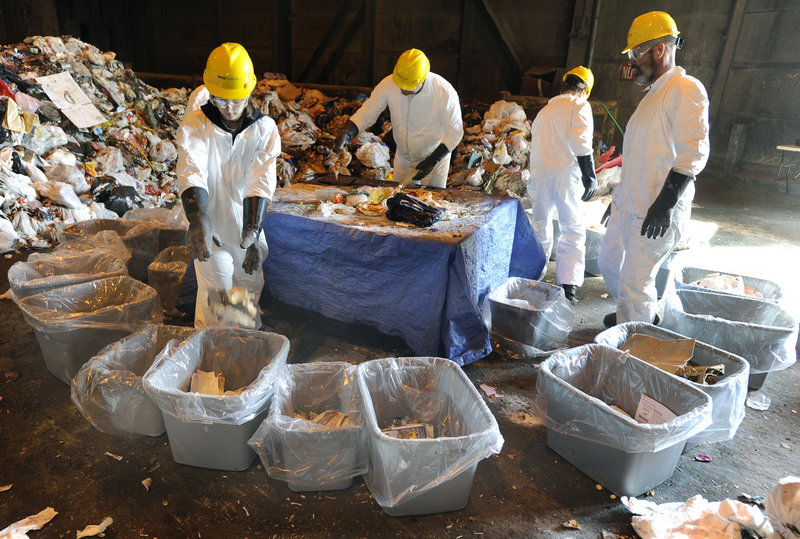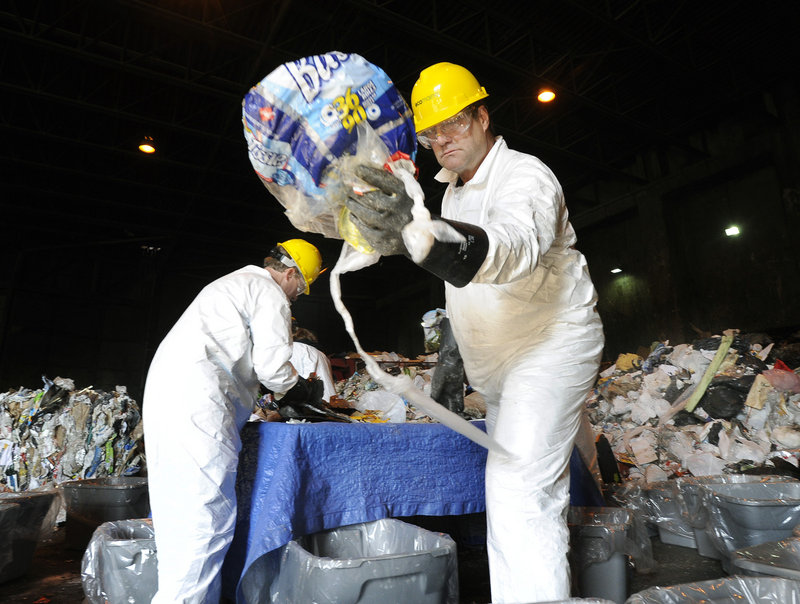PORTLAND — Trash thrown away by Scarborough residents usually goes straight to ecomaine’s waste-to-energy plant, but this week it made a pit stop before being burned.
The waste was dumped on the plant’s tipping hall floor, where a six-person crew — dressed in white jumpsuits, yellow hard hats, goggles and gloves — sorted about 400 pounds of it into 30 containers on Wednesday.
The workers were hired by the University of Maine’s School of Economics, which is conducting a study on the effectiveness of recycling programs in the state.
Students from the university were paid to sort trash from 17 towns in 14 counties this summer. Now that they’re back in school, hired workers are returning to those towns to document how the composition of trash varies from season to season.
The sorters separate the trash into 65 categories and weigh each pile.
Economics Professor George Criner, who’s leading the study, said most municipalities in Maine offer some way for residents to recycle tin cans, clear glass and newspaper. The question is whether they do it.
By learning how much recyclable material residents are throwing away, towns can determine whether their recycling programs are effective, he said.
Criner said the communities chosen to participate in the study represent a variety of collection programs, including single-stream, drop-off and curbside.
The researchers will write reports for each town, as well as a paper on the overall results of the study.
Informing towns about whether their residents are recycling is just one purpose of analyzing the trash.
The State Planning Office initiated and funded the $70,000 study to help predict and then plan for Maine’s future landfill needs.
On a smaller scale, the research has already had an effect.
Travis Blackmer, a senior economics major who’s helping with the study, said his recycling habits have changed since he sorted — and smelled — the piles of trash. Seeing all the paper towels thrown away, he said, has convinced him to cut back on his use of the product.
Blackmer said he hopes most Maine residents won’t need the same firsthand experience to convince them to alter their ways. He hopes the reports, which are slated to be done before March, will have a similar effect.
The researchers have released some preliminary findings from the data that was collected last summer.
They found that tin, glass, newspaper and other traditionally recycled materials make up about 20 percent of Mainers’ trash, Criner said. About another 30 percent is food waste, which could be composted.
That means, if all residents were compliant with their recycling programs and started composting their food scraps, the state’s waste stream could be cut in half.
Financially, that could have a significant impact on municipalities. Criner said waste management is often one of the top three expenses for towns and cities.
Because of that, they’ve been cooperative and even eager to have their trash analyzed, he said.
And it’s been interesting work for the sorters.
Karl Chandler, a project manager on site at ecomaine Wednesday, said some eye-opening items have surfaced, including a dead chipmunk, bags of marijuana and a frozen rooster, “feathers and all,” he said.
Another manager, Michael Merchant, said he’s collected some useful items for himself, including Christmas lights and several working watches.
“It’s amazing the stuff people will toss,” he said. “You just can’t imagine.”
Staff Writer Leslie Bridgers can be contacted at 791-6364 or at: lbridgers@pressherald.com
Send questions/comments to the editors.





Success. Please wait for the page to reload. If the page does not reload within 5 seconds, please refresh the page.
Enter your email and password to access comments.
Hi, to comment on stories you must . This profile is in addition to your subscription and website login.
Already have a commenting profile? .
Invalid username/password.
Please check your email to confirm and complete your registration.
Only subscribers are eligible to post comments. Please subscribe or login first for digital access. Here’s why.
Use the form below to reset your password. When you've submitted your account email, we will send an email with a reset code.